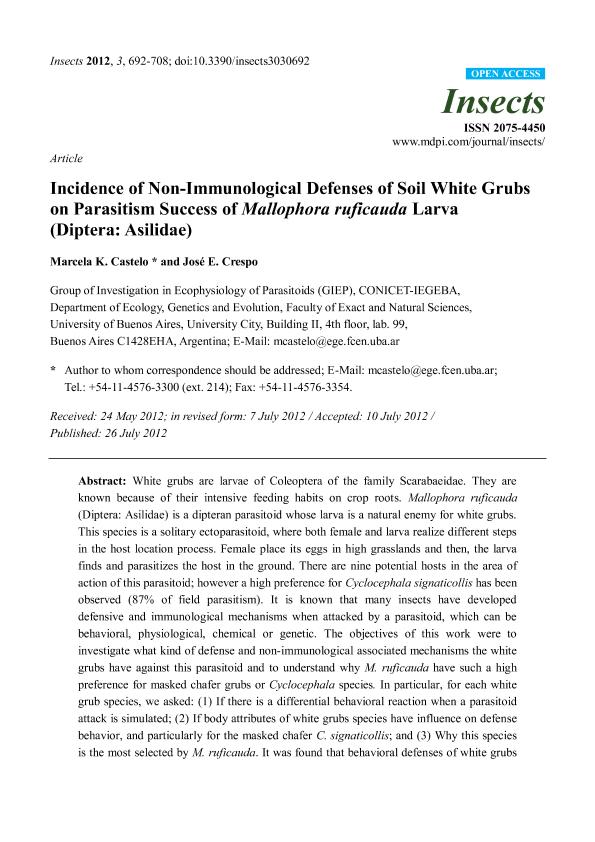Artículo
Incidence of non-immunological defenses of soil white grubs on parasitism success of mallophora ruficauda larva (Diptera: Asilidae)
Fecha de publicación:
07/2012
Editorial:
MDPI AG
Revista:
Insects
ISSN:
2075-4450
Idioma:
Inglés
Tipo de recurso:
Artículo publicado
Clasificación temática:
Resumen
White grubs are larvae of Coleoptera of the family Scarabaeidae. They are known because of their intensive feeding habits on crop roots. Mallophora ruficauda (Diptera: Asilidae) is a dipteran parasitoid whose larva is a natural enemy for white grubs. This species is a solitary ectoparasitoid, where both female and larva realize different steps in the host location process. Female place its eggs in high grasslands and then, the larva finds and parasitizes the host in the ground. There are nine potential hosts in the area of action of this parasitoid; however a high preference for Cyclocephala signaticollis has been observed (87% of field parasitism). It is known that many insects have developed defensive and immunological mechanisms when attacked by a parasitoid, which can be behavioral, physiological, chemical or genetic. The objectives of this work were toinvestigate what kind of defense and non-immunological associated mechanisms the white grubs have against this parasitoid and to understand why M. ruficauda have such a high preference for masked chafer grubs or Cyclocephala species. In particular, for each white grub species, we asked: (1) If there is a differential behavioral reaction when a parasitoid attack is simulated; (2) If body attributes of white grubs species have influence on defense behavior, and particularly for the masked chafer C. signaticollis; and (3) Why this species is the most selected by M. ruficauda. It was found that behavioral defenses of white grubs would explain the parasitism pattern of M. ruficauda larvae and its preference for C. signaticollis.
Palabras clave:
HOST VULNERABILITY
,
PARASITOIDS
,
SCARABAEIDAE
Archivos asociados
Licencia
Identificadores
Colecciones
Articulos(IEGEBA)
Articulos de INSTITUTO DE ECOLOGIA, GENETICA Y EVOLUCION DE BS. AS
Articulos de INSTITUTO DE ECOLOGIA, GENETICA Y EVOLUCION DE BS. AS
Articulos(OCA CIUDAD UNIVERSITARIA)
Articulos de OFICINA DE COORDINACION ADMINISTRATIVA CIUDAD UNIVERSITARIA
Articulos de OFICINA DE COORDINACION ADMINISTRATIVA CIUDAD UNIVERSITARIA
Citación
Castelo, Marcela Karina; Crespo, José Emilio; Incidence of non-immunological defenses of soil white grubs on parasitism success of mallophora ruficauda larva (Diptera: Asilidae); MDPI AG; Insects; 3; 3; 7-2012; 692-708
Compartir
Altmétricas




